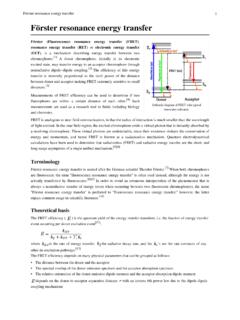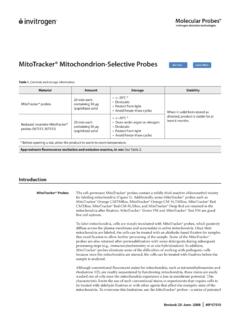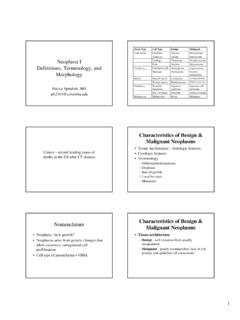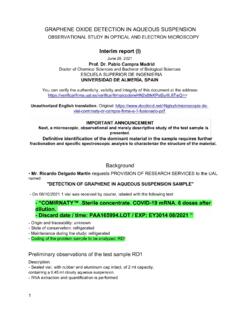Transcription of Polymer-Modified Asphalt 101
1 Polymer-Modified Asphalt 101. Chris Lubbers Technical Sales and Market Dev. Mgr. Kraton Performance Polymers, Inc. AZ DOT + Local Agency Training Seminar 11/12/14. Outline Reasons for Asphalt Modification Primary Distresses in Asphalt Pavements Polymers for Asphalt + Emulsion Modification Plus Testing for polymer Modification Chip Seal and Micro Surfacing polymer Morphology and Compatibility PMA Storage and Handling Reasons for Asphalt Modification The perception that Asphalt cement has changed since the 1970's. Traffic factors have increased: including heavier loads, higher volumes and radial tires with higher tire pressures. (Twofold increase in truck traffic from 1974-1989.)
2 Deferred maintenance because of funding shortages. Higher costs have created a tendency to construct thinner pavements, thus reducing the service life of the pavement. To meet new Superpave design specifications. Distresses in Asphalt Pavements High Temperature Permanent Deformation Low Temperature Thermal Cracking Load-Associated Fatigue Cracking Aging Stripping High Temperature Permanent Deformation High Temperature Permanent Deformation (Rutting). Rutting is caused by the accumulated plastic deformation (flow) in the Asphalt mixture with repeated application of loads at upper pavement service temperatures. Rutting is predominantly influenced by the aggregate and mix design.
3 Modifiers can stiffen the binder and provide a more elastic material. High Temperature Performance I-80, Nevada (FHWA). Same gradation - different binders. PG 64-22 modified PG 64-22 unmodified No rutting TG63 15mm of rutting TG67. Low Temperature Thermal Cracking Low Temperature Thermal Cracking Thermal shrinkage cracking results from either a single thermal cycle where the temperature reaches a critical low temperature (Single Event Thermal Cracking) or from thermal cycling above the critical low temperature (Thermal Fatigue). Low Temperature Thermal Cracking is predominantly influenced by the binder properties. Modifiers can improve the low temperature flexibility of the mixture.
4 Load-Associated Fatigue Cracking Load-Associated Fatigue Cracking Load-associated fatigue cracking is caused by continuous application of loads over a period of time. Load-associated fatigue cracking is influenced by both binder and mixture properties. Aging Aging or embrittlement occurs during the mixing and laydown process and during the service life of the Asphalt . The Asphalt binder displays large increases in stiffness due to oxidation and volatile loss in the binder. Stripping Stripping is loss of bond between the aggregates and Asphalt binder which typically begins at the bottom of the HMA layer and progresses upward. Stripping is driven by the aggregate's surface affinity for water.
5 Additives can change the surface of the aggregate from hydrophilic (water-loving) to hydrophobic (water-hating). Ideal Asphalt Binder and Asphalt Mixture Displays improved resistance to previously mentioned distresses. Improves lifecycle cost of the Asphalt pavement. Improved Safety. Use of modified Asphalts Hot Mix Asphalt (HMA). Dense Graded Mix Stone Matrix Asphalt (SMA). OGFC. What are Polymers? Comprised of many small molecules Poly = many Monomers = small molecules or repeat units Monomers chemically react larger molecules Water-based polymers latex form (SBR). Solvent-based polymers pellets, bale (SB-,SBS). Properties are determined by: Types and sequence of monomers Molecular weight Typical Monomers H H H.
6 H. C C C C H. H. H H. C C. H H H H. Butadiene H H Mw ~ 54 g/mol Styrene Mw ~ 104 g/mol Polymers for Asphalt Modification Elastomer Styrene-Butadiene Rubber - SBR. Latex form polymer particles dispersed in water Random monomer addition typ. 75/25 BD/styrene High molecular weight 1,000,000 g/mole 13,900 BD mers , 2400 styrene mers . Broad distribution chains many different lengths Polymers for Asphalt Modification Elastomer Polyisoprene Natural Rubber Latex form polymer particles dispersed in water Homopolymer of isoprene harvested from trees High molecular weight 1,000,000 g/mole Broad distribution chains many different lengths H CH3 Isoprene C C H Mw ~ 68 g/mol H C C.
7 H H. Polymers for Asphalt Modification Thermoplastic Elastomers Styrene-BD-Styrene block copolymer SB-, SBS. Monomers blocked in polymer backbone Typically 70/30 BD/styrene Lower molecular weight 100,000 g/mole 1300 BD mers , 288 styrene mers . Narrow distribution all chains similar length Polymers for Asphalt Modification Thermoplastic Ethylene vinyl acetate (EVA) resin Vinyl acetate content ~ 20% to 40%. Low Tg, high melt temp due to crystallinity Thermoset Ground tire rubber (GTR). Mixtures of E-SBR, S-SBR, PBd, natural rubber Depends on tire component Tread, sidewall, innerliner (halobutyl), . polymer Modification of Asphalt Emulsions Emulsify polymer modified Asphalt Pre- modified emulsion Polymers SBS, SB-, EVA.
8 Higher mod. Asphalt viscosity higher Asphalt + mill temp. Exit temp. > 100oC. Heat exchanger, back press. polymer inside Asphalt droplet polymer Modification of Asphalt Emulsions Add latex external to Asphalt Methods soap batching co-milling Asphalt line co-milling soap line Polymers SBR, NR latex Lower Asphalt process T. No special mill, handling polymer in water phase Continuous polymer film formation on curing Micro Surfacing polymer Morphology in Field Texas State Highway 84. Near Waco,TX. 5mm Paved in 1998. Samples taken in 2001. Viscoelastic Behavior Polymers + Asphalt +09. G* = f(T) = res. to deform. AAA-1 Asphalt +08. Asphalt Complex Modulus [G*], Pa +07.
9 High G* at low T brittle Low G* at high T viscous +06. SBR polymer DG*(80oC 20oC) = 1000x +05. Low T g SBR polymer High Molecular +04. Weight Lower G* at low T flexible Higher G* at high T elastic +03. -60 -40 -20 0 20 40 60 80 DG*(80oC 20oC) = 10x Temperature, C. Force Ductility & Elastic Recovery Force Ductility modified Binder should outperform neat binders by breaking at larger deformation Force Ductility Unmodified PG 64-22. Stress Same 64-22 With SB Modification 0 10 20 30 40 50 60 70 80. Elongation, cm Elastic Recovery 1 2. Neat doesn't recover modified recovers 3 4. Typical PG Plus Specs PG 76-22. Force Ductility Ratio, Spec. min.
10 Break stress / Maximum stress Tested at 4C. Elastic Recovery, Spec. 65-75% minimum ASTM D6084 10 cm pull, cut immediately AASHTO T301 20 cm pull, wait 5 min. Hybrid ASTM D6084/AASHTO T301. Original or RTFO-aged binder Tested at 10C or 25C. Chip Seal CRS-2. Early Strength Development 100 With Unmodified CRS-2. 90 % Aggregate Retained Water Absorption, %. 80 70 60 Water wicks agg. surface Positive correlation 50 early chip retention A B C D E F G H. Data provided by Paragon agg. H2O absorptivity Aggregate Samples Technical Services Early Strength Development CRS-2P. ASTM D7000-04 Sweep Test 100. % Aggregate Retained 90. 80 Potential Chip Loss 70.








